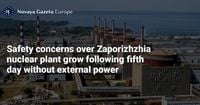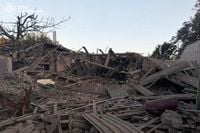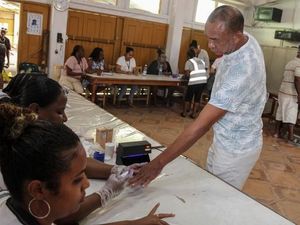The Zaporizhzhia Nuclear Power Plant, Europe’s largest nuclear facility, has entered its fifth consecutive day operating solely on emergency diesel generators, intensifying international fears of a potential nuclear disaster as the war in Ukraine grinds on. The plant, located near the front lines in southeastern Ukraine and under Russian occupation since early 2022, has been cut off from external power since September 23, 2025—a record outage that has drawn sharp warnings from nuclear safety experts, environmental watchdogs, and government officials on both sides of the conflict.
The situation at Zaporizhzhia is unprecedented in the history of nuclear power in Europe. According to The Associated Press, the plant’s six reactors, though in cold shutdown since September 2022, still require a steady supply of electricity to power their cooling and safety systems. Without this, the risk of overheating and potential meltdown becomes alarmingly real. As of September 27, 2025, the entire facility has been running on backup diesel generators, a measure nuclear professionals consider a last resort.
“Emergency diesel generators are considered the last line of defense, used only in extreme circumstances,” Jan Vande Putte, a radiation and nuclear safety expert for Greenpeace Ukraine, told AP. He added, “These are undoubtedly the most serious and important events since the beginning of the occupation of the ZNPP by Russia in March 2022.”
The immediate cause of the blackout is hotly contested. Ukrainian officials, including Foreign Minister Andriy Sybiha, have blamed Russian shelling for damaging the last remaining power transmission line connecting the plant to Ukraine’s grid. “As a result of Russian actions, the Zaporizhzhia NPP has been without power for the fourth day,” Sybiha posted on X (formerly Twitter). On the other hand, Russian sources claim Ukrainian attacks are to blame, with the Moscow-backed operator of the station stating on Telegram that “from September 23, 2025, the power supply for the needs of the Zaporizhzhia nuclear power plant is provided by backup diesel generators.”
Despite the finger-pointing, both sides agree on the gravity of the risk. Stress tests conducted by European regulators after the 2011 Fukushima disaster in Japan suggested nuclear plants could operate without external power for up to 72 hours, but the current outage has already exceeded that threshold. “Any additional period was as yet untested,” The Guardian reported, underscoring the uncertainty that now hangs over Zaporizhzhia.
Greenpeace Ukraine has raised the alarm that the ongoing crisis could be part of a deliberate Russian strategy to sever the plant from Ukraine’s grid and reconnect it to the Russian-occupied territories. Satellite imagery analyzed by the group shows construction of a 201-kilometer (125-mile) power line stretching from Russian-controlled substations in Mariupol and Melitopol toward the plant, as well as a new water supply system for the cooling ponds. “There are signs that Russia is close to connecting a new power line through the occupied territories,” Greenpeace warned, suggesting Moscow may be preparing to restart at least one reactor despite the high risks.
Yuri Chernichuk, the Moscow-appointed director of the power station, has openly discussed the integration of Zaporizhzhia into the Russian grid. In January 2025, he told the Russian news agency TASS that this process was “in the final stages,” and just a week ago reaffirmed that integration was nearly complete—though launching a reactor during wartime, experts agree, would be unprecedented and perilous.
Zaporizhzhia’s reliance on diesel generators is not just a technical detail; it’s a race against time. The plant’s Russian-controlled Telegram channel insisted on September 27, 2025, that “sufficient diesel fuel reserves are available on-site to ensure long-term autonomous operation of the generators.” The IAEA, the United Nations’ nuclear watchdog, was told by Russian operators that there was enough fuel for 20 days without resupply. But as AP and The Guardian both note, the situation is fraught: if even a few of the 18 available generators fail, the cooling systems could stop, leading to uncontrolled heating of the nuclear fuel in any or all of the six reactors.
“Seven of the eighteen available generators currently provide cooling, but if they fail, the nuclear fuel in the six reactors could heat up uncontrollably for weeks, potentially leading to a meltdown,” experts told Online.ua. The memory of Fukushima looms large. There, a loss of power after an earthquake and tsunami led to three nuclear rods melting in three days, forcing the evacuation of over 100,000 people, though there were no immediate deaths. At Zaporizhzhia, the risk is compounded by the ongoing conflict, which has seen regular shelling, power cuts, and staff shortages at the plant.
The international response has been swift but so far ineffective. IAEA Director General Rafael Grossi visited Moscow this week for talks with President Vladimir Putin and Russia’s nuclear agency Rosatom, but the external power supply was not restored. Grossi described the meeting as a “timely and important exchange” and is expected to travel to Kyiv next to discuss the crisis with Ukrainian officials. Meanwhile, Ukrainian Foreign Affairs Minister Sybiha called on the IAEA to “adopt a principled stance,” demanding that “the Zaporizhzhia Nuclear Power Plant must be returned to Ukraine, its rightful owner.”
While the nuclear crisis dominates headlines, the war’s broader context is never far away. On September 27, 2025, Ukrainian President Volodymyr Zelenskyy announced a $90 billion arms deal with the United States, which includes a separate “drone deal” for Ukrainian-made drones. “We discussed and agreed on the main points with the President (Trump). Now we are moving on to practical implementation,” Zelenskyy said at a Kyiv press briefing. He also revealed that an Israeli Patriot air defense system has been operational in Ukraine for the past month, with two additional systems expected to arrive in the fall.
The Zaporizhzhia crisis has also become a flashpoint in the information war between Moscow and Kyiv. Both governments have accused each other of endangering the plant and the broader region. As the plant sits near the Dnieper River, close to the front line, the risk of a nuclear incident—whether by accident or design—remains a pressing concern for all of Europe.
For now, the world watches anxiously as Zaporizhzhia’s fate hangs in the balance, a stark reminder of the dangers posed when war and nuclear technology collide. The next few days could prove critical—not just for Ukraine, but for the safety of the continent.





